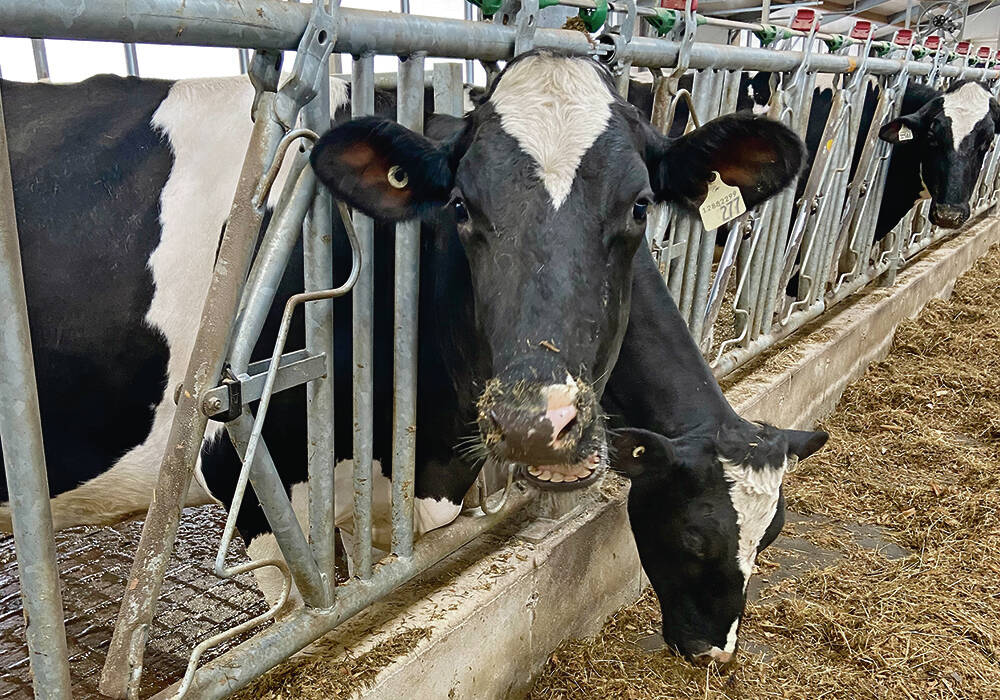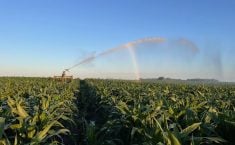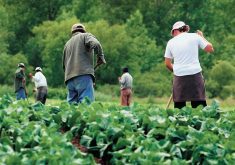American farmers will receive record-high amounts of farm aid this year, but Canadian producers say they don’t want a handout — just a business risk management program that works.
The current programs, such as AgriStability, don’t function well, said Sexsmith-area farmer Greg Sears.

“It’s not predictable, it’s not timely, and it rarely pays out — that’s a challenge,” he said.
“Farmers aren’t looking for handouts, but we do need some things that help us manage our business risk.”
Worldwide, farmers are now receiving a mind-boggling $2 billion per day in farm aid, the Organization for Economic Co-Operation and Development said recently after adding up government payouts to farmers in 54 countries. Some countries, like China and Russia, have increased their supports over the past two decades. Others, like South Korea and Japan, have dropped their rate of support, but over 40 per cent of gross farm revenues are still from support programs — well above the 12 per cent global average.
Canada is well below average with just eight per cent of gross farm revenues coming from government — a sea change from the mid-1980s when it was 35 per cent. The U.S. was on that path, too, coming in at about 11 per cent until recently. In 2018, a $5.1-billion ‘market facilitation program’ (meant to compensate for price drops from trade issues) pushed total farm aid to nearly $14 billion. This year, thanks to a $16-billion pandemic aid package, American farmers are set to receive nearly $33 billion in government support — as much as $250,000 each.
There’s nothing like that here.
“Through the pandemic, (the support) has been pretty minimal,” said Sears. “What we’ve seen is additional opportunities for farm owners to borrow more money and get more in debt, but very little tangible and immediate support.”
The Canadian Emergency Business Account program offers $40,000 in an interest-free loan (up to $10,000 of which will be forgiven), but getting it to pay out has been a challenge for some farmers. John Guelly, who farms near Westlock, has applied for it twice and hasn’t had any luck.

“The first application was declined, and they don’t really tell you why. It’s very frustrating,” said Guelly, who is also critical of the “ludicrous payouts” south of the border.
But the OECD report also underscores a growing gap between the support Canadian farmers receive compared to their competitors.
“Most farmers don’t want handouts. They want to compete fairly and evenly without subsidies,” said Guelly. “But if other countries aren’t playing on a level playing field, we certainly need to be able to compete with them.”
The ‘better solution’
Bentley-area producer Kevin Bender agrees.

“I’ve been a strong advocate for a policy environment that allows us to do what we do best, and I think, given a level playing field, Canadian farmers can compete with anybody in the world,” he said.
“All things equal, I think we can rise to the top. But when they throw in money that Canada can’t compete against, it un-levels the playing field. It makes it unequal.
“It certainly is a problem when our competitors are being subsidized and we’re not.”
But further farm subsidies here in Canada aren’t the right answer either, said Hannah Konschuh, who farms near Cluny.
“While it is frustrating to see the support that farmers south of the border and in other countries receive, we know that it just doesn’t work,” said Konschuh, pointing to ad hoc payments from the 1980s and 90s as proof of that.
“Even if Canada did have the capacity to make those direct payments to farmers — which we don’t — I don’t think it would get us any further than we are today. The better solution is for farmers to have their income come from the market.”
What Canadian farmers really need, she said, “is the backstop of robust business risk management programs” that pay out when needed.
“They need to have these programs that they can pay into that provide them insurance and that give them the resiliency to keep farming when they need it,” she said.
AgriStability specifically is a challenge for farmers, she added.

“The biggest issue with that program in particular is that it lacks when it comes to being bankable, being predictable, and being responsive to the challenges that farmers are facing,” she said.
“In 2020, my farm has seen a decent amount of moisture, so we have decent-looking crops. But in prior years — 2017 to 2019 — we’ve essentially been in a drought. We found that when we needed that program to be responsive, it wasn’t.”
Farmers across Canada have been calling for changes to AgriStability almost since its inception in 2007. But so far, the most significant change they’ve seen is a reduction in the payment claim trigger from 85 per cent of a farm’s reference margin down to 70 per cent in 2013.
Read Also

Alberta Milk opens annual hospital fundraiser
Alberta Milk embarks on holiday season campaign to raise money for Alberta Children’s Hospital Foundation
At the same time, reference margin limiting was introduced. It is determined by excluding the highest and lowest program margins in the previous five years and averaging the remaining three.
Those two things combined “make AgriStability very difficult to count on to support you in all but the most catastrophic of situations,” said Sears.
“Even then, is it bankable? Can you go to your creditors and say, ‘I had a horrible year, but I know AgriStability is going to come to my aid’? I don’t think we can say that right now.”
Barriers and options
As a result, participation in the program has dropped off over the years.
“A lot of people just said it’s not worth it,” said Bender.
That was the case on Guelly’s farm.
“With the existing system that we have now, I know I’ve had a couple of crop failures and still didn’t qualify for AgriStability, so I got out of it,” he said.
Various industry groups have been pushing for changes, but so far, government support for those changes hasn’t materialized.
“The industry has actually, in a very surprising form, come together in alignment regarding where we need that program to go,” said Konschuh.
“It’s such a rare thing and such a great thing that there’s so much alignment. But what we’re seeing is a lack of action on that from government, both at the federal level and at the provincial level.
“It’s time for that change to happen.”
Right now, the agriculture industry is working on the next Canadian Agricultural Partnership policy framework (which business risk management programs fall under), so as a “bridge to the next round of funding,” farm groups have asked for a short-term removal of the reference margin limit in AgriStability.
In the longer term, they would like to make that change permanent and increase the payment trigger back up to a “more responsive level” of 85 per cent.
“These are all things that have been communicated to government at all levels,” said Konschuh, who vice chair of Alberta Wheat. “What we need is action on the government side to make it happen.”
Some have, she added. In February, the B.C. government announced a boost to the 2019 and 2020 AgriStability program years that increased the compensation rate from 70 per cent to 80 per cent when reference margins fall below the 30 per cent payment threshold.
“B.C. has modified their AgriStability program in the short term, so we know that it can be done,” she said. “It’s just the willingness on the policymakers’ side to get it done.”
That willingness has been in short supply. Both the federal and provincial governments have trimmed their agriculture budgets already, and Guelly suspects that’s at least part of the reason these changes haven’t come.
“Both federal and provincial governments don’t necessarily want to spend more money on agriculture,” he said. “It’s going to cost them that much more money, and they don’t seem willing to invest in agriculture right now.”
One idea that’s been floated around is a base level of government support that could then be supplemented through additional coverage by the farmer.
“Maybe we need to look at sharing more costs between farmers and the government. Maybe that will get them more interested in making some changes,” said Guelly.
Staying in the game
Another challenge is the sheer size of the industry and the different players involved in AgriStability.
“Our farms are so different, so it’s next to impossible to have a program that works 100 per cent for everybody,” said Bender.
“To try and get something that works for the majority is probably a really difficult thing. I think that’s why we haven’t found a silver bullet yet.”
“There’s many players involved in making that decision,” Konschuh added. “These programs are funded both federally and provincially, so there’s a lot of politics involved.”
Beyond that, the current federal government is “very much an urban-focused government,” said Sears.
“I think it’s becoming more and more difficult to get them to recognize the importance of agriculture to the Canadian economy and the Canadian population in general,” he said.
“We need to present our case to the different levels of government and to the population in general about the importance of agriculture and our contributions to the economy. We’re really a foundation of the Canadian economy.”
But that foundation will start to crumble without changes to these government support programs, he said.
“Commodity prices are flat at best. Input prices are going up. So our margins continue to get tighter, and with that, your ability to absorb risk as a producer is diminished,” said Sears.
“If you don’t have the ability to manage that risk, the quote-unquote average farmer isn’t going to be able to feed their families on their land-base.
“It’s more and more difficult for the average farmer to manage the financial risk of remaining in operation.”
Already, farms have been consolidating. In 2016, the number of farms in Canada dropped by almost six per cent from the last census in 2011, while the total land base being farmed increased by seven per cent in that time.
“Things are less family farmed and more corporate farmed, and if we want to keep the next generation involved in agriculture in Canada, we’ve got to be able to support these young farmers as they start up,” said Guelly.
“Surviving a crop failure as an established farmer is way easier to handle than trying to survive a crop failure if you’re just starting out.”
Konschuh agrees.
“I’m not just a young farmer — I’m farming on a young farm,” said the second-generation producer. “These programs are vital to my farm because we don’t have those extra generations of accumulated wealth or accumulated resiliency built up.
“Having these programs be responsive is such an important thing. They’re a key part of how we manage risk.”















